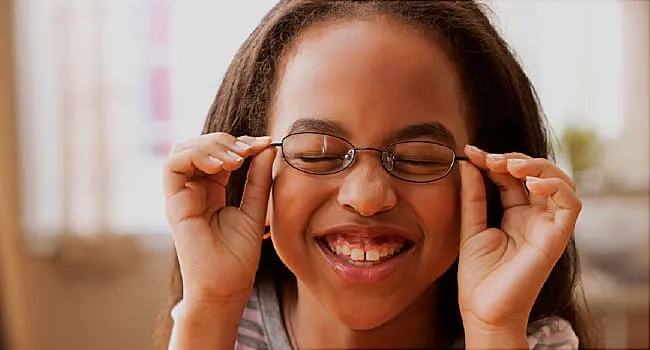Have you been told that your child needs glasses or contacts? Health experts estimate that almost half the U.S. population — 42% — has myopia (nearsighted ness), a figure that has almost doubled over the past 3 decades and continues to grow. But being nearsighted is more than just an inconvenience: It can pose long-term hazards.
While glasses, contact lenses, eyedrops, and surgery can help kids see clearly, they don’t stop myopia from getting worse. Myopia occurs due to a slightly elongated eyeball or a steep curve in the cornea (the clear part in front of the eye). As a result, the light coming into the eye focuses in front of the retina instead of on it. This causes blurred vision.
“When the eye becomes longer, the tissue of the retina and the structures supporting the optic nerve stretch and become thinner,” says Andrei Tkatchenko, MD, PhD, associate professor of ophthalmic sciences at Columbia University Irving Medical Center in New York. “This thinning increases the risk of retinal detachment, cataracts, glaucoma, and even blindness. The faster myopia progresses and the more the prescription increases, the greater the risk of these diseases.”
Children with nearsighted parents are more likely to be nearsighted themselves, and scientists have identified a lot of myopia-related genes. But genes usually combine with a person’s environment to cause a disease. The top thing in the environment linked to myopia is close-up work such as reading or working on a computer or smart device. “Over the past 3 decades, the level of near work has significantly increased in most of the world,” Tkatchenko says. He and other researchers are studying new methods for treating myopia.
How to Slow Down Myopia
Can the advance of myopia be slowed or even halted to prevent long-term complications? Tkatchenko says yes: “There is a clearly defined treatable period between ages 8 and 25 during which there is the greatest progression of myopia, and myopia control is most effective during those years.”
For those diagnosed with severe myopia, known as high myopia, special contacts worn at night can help reshape the cornea and stabilize the eye to help with vision. That’s called orthokeratology, or Ortho-K. But experts aren’t sure if it can stop myopia from getting worse.
Multifocal contact lenses worn during the day work to slow the progression of myopia in kids while also creating clear vision. MiSight lenses are the only ones approved by the FDA to stop myopia progression. A 3-year study showed that they slowed myopia down by 43% and slowed eye growth by 36%. When researchers tested MiSight over a 6-year period, they saw that myopia slowed even in children who started with single-vision contact lenses (which make vision clearer but don’t slow progression of myopia) and later switched to MiSight.
Nicholas Onken, OD, assistant professor at the University of Alabama at Birmingham, says NaturalVue is another daily disposable multifocal contact lens that can be used on an off-label basis to help with myopia. This means the product is approved by the FDA but not to stop myopia from getting worse. “I use this lens as a second option in the rare event that a patient finds the MiSight lenses uncomfortable,” Onken says.
“Myopia control is most effective when initiated as early as possible, so I am often recommending MiSight as soon as a child fits the parameters,” Onken says. “In a child who is not yet nearsighted but who appears to be headed in that direction, I will make sure to mention myopia control contact lenses to the parents so they have time to think over it and digest the idea of putting their child in contact lenses.”
Doctors also use atropine eye drops for myopia control, but they’re also prescribed only on an off-label basis, Onken says. He only recommends atropine eye drops before MiSight contacts if kids are under 4 years old or so.
Researchers are looking into other potential treatments for myopia including red light exposure and chromatic aberrations, Onken says.
How to Deal With Myopia Now
It’s important to make sure your child has the proper prescription for their glasses or lenses. An under-, and more importantly, over-corrected lens could make myopia worse.
But there’s one simple prescription that could protect your child from getting myopia in the first place: spending time outside. “A number of studies have shown that outside activities suppress the development of myopia,” Tkatchenko says. Scientists aren’t sure why this happens, but one theory is that outdoor light stimulates the release of chemicals that signal the eye to slow its growth to a normal rate.
“Go outside and play. That’s the best thing parents can tell their children to help prevent myopia,” Tkatchenko says.
By the Numbers
66%: Percentage increase in myopia in the U.S. between the early 1970s and early 2000s.
50%: Percentage of the world’s population that will have myopia by 2050.
4 in 10: Ratio of adults in the U.S. who have myopia.
1.25: Number of daily hours of outdoor time needed to cut the chance that a child will get myopia by 50%.
https://img.webmd.com/vim/live/webmd/consumer_assets/site_images/article_thumbnails/other/girl_with_glasses_other/650x350_girl_with_glasses_other.jpg
2023-04-05 21:18:52





